AMD Delivers Crimson ReLive Drivers: Yearly Feature Update for Radeon Gamers and Professionals
by Ian Cutress on December 8, 2016 9:00 AM ESTCrimson ReLive: Radeon Pro Drivers
The rebrand of the FirePro line of professional GPUs to Radeon Pro has been, as probably expected by the professional environment, a slow and steady trek. Over the past couple of years, a number of initiatives from AMD to integrate professional style workflows into something that can be optimized under AMD have been in place. As a result AMD is making the launch of this next generation package a marked uptick for an increased level of platform testing, ISV certification, and more stress testing under professional level requirements.
This extends to performance as well, particularly on popular software on both older FirePro and the new Radeon Pro cards.
With the ReLive update, AMD is committing to Enterprise users (data centers, HPC, large clients) that there will be a regular cadence of driver updates throughout 2017, with the 4th Thursday of each quarter (so 1/26, 4/27, 7/27 and 10/26) marked for official releases.
The Radeon Pro drivers and the regular drivers, despite still being separate packages, are set to integrate more common features between them during 2017. This includes game engine support, allowing professional workflows to take advantage of DX12 for CAD visualization or modeling in Unity with professional cards. LiquidVR will also come to the Pro driver set for specific cards (WX7100, Pro Duo, W9100), enabling VR workflows for a number of ISV packages as shown below.
The Radeon Pro driver for Linux is also being improved with AMD offering an both open source driver core as well as a proprietary driver set. The latter was explained as specifically pointing to larger install/professional bases that might have additional IP requirements to which an open-source implementation might not be sufficient. Nonetheless, this means FreeSync 1.0 on Linux, improved performance for Pro WX and FirePro W cards under Ubuntu, RedHat and CentOS.
The launch of ReLive for Radeon Pro will also include support for vmware vSphere 6.5, allowing direct GPU virtualization for FirePro S7100X/S7150/S7150 X2 cards and deterministic performance across multiple VMs. AMD is keen to stress that there are no licensing fees for this and these drivers in virtualized environments also come with a number of high-priority ISV certifications that a number of customers demand.


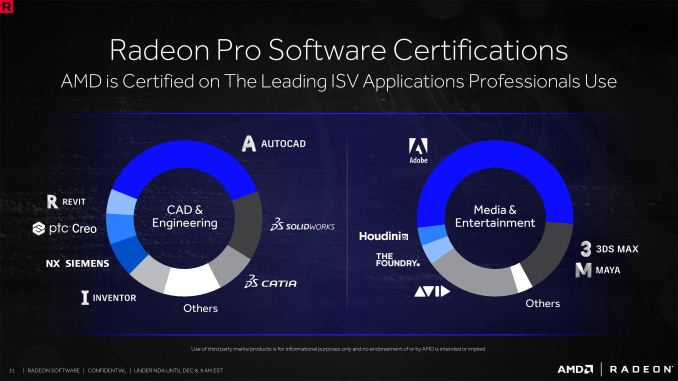
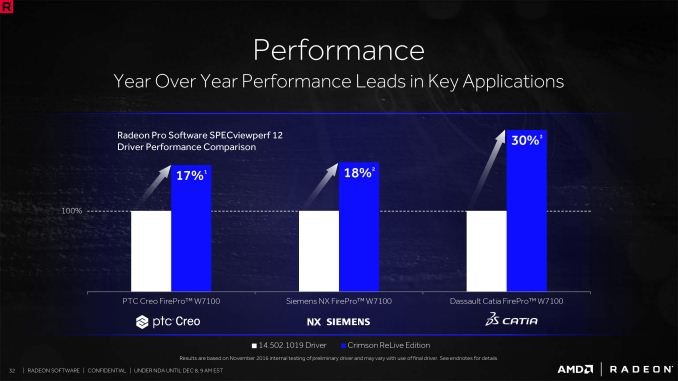
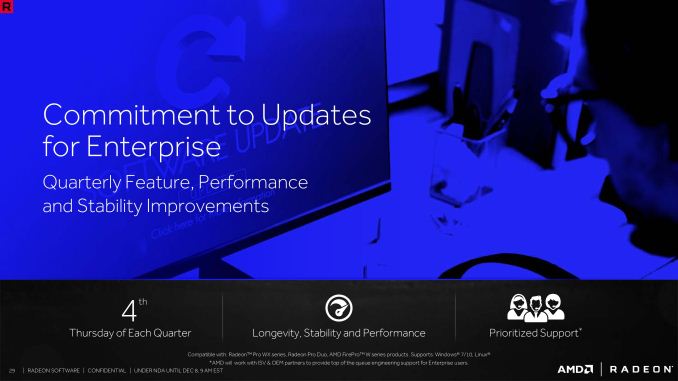
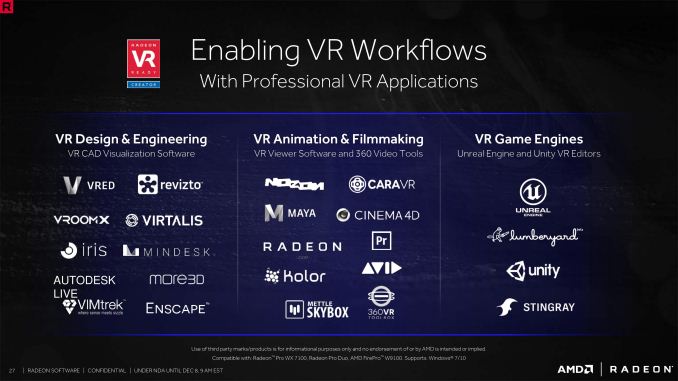
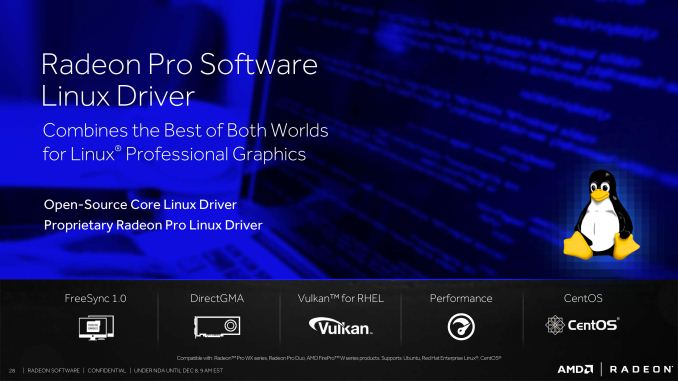









48 Comments
View All Comments
negusp - Thursday, December 8, 2016 - link
Linux support, AMD?negusp - Thursday, December 8, 2016 - link
Yes, you dork.BrokenCrayons - Thursday, December 8, 2016 - link
I'm hopeful they can improve since I don't want to have my choice of Intel or Nvidia on Linux for my next graphics card upgrade.coder111 - Thursday, December 8, 2016 - link
Wait what? AMD is great on Linux. The most FPS you can get with open-source drivers. And it's getting better by the day.NVidia is still better if you are willing to run BLOBs. But I don't want to deal with that hassle.
Read phoronix for more Linux benchmarks.
negusp - Thursday, December 8, 2016 - link
AMD is horrible on Linux. The fglrx driver has no support and the open-source drivers aren't great. OpenGL performance is really quite bad as well.Azurael - Thursday, December 8, 2016 - link
I don't get it, have you guys actually used AMD under linux recently? On the 7870 I just pulled out of my machine (and presumably at least all the GCN1.x cores, I know the later models use amdgpu which I've not tried), the radeonhd driver is totally stable now and fully supports OpenGL 4.5 and so far as I could see matches or betters the performance of the Windows drivers (though it's difficult to compare cross-OS, I wasn't about to mess up my Gentoo install with the proprietaries)Since I stuck a GTX 970 in my machine, I've realised it's actually Nvidia who are the laughing stock with drivers these days. In a matter of months, I've had stability problems under Windows, performance regressions with new drivers, the open source 'nouveau' driver won't even boot on said 970 as of 4.8.x without a bunch of kernel patches that just about enable 2D acceleration (but not at 1440, only 1080)
The proprietary Linux drivers are okay but it's a right pain in the backside having to remember to rebuild them every time I do a kernel update, plus they have no framebuffer console support so if something goes wrong before GDM starts successfully, I have to SSH into my machine to resolve it.
Azurael - Thursday, December 8, 2016 - link
I should add that I can't use a VGA framebuffer because it's an EFI-booting system, and efifb conflicts with the proprietary Nvidia drivers. They are a joke. And that's before we get on to the DX12/Vulkan performance. I wouldn't be at all surprised if my old 7870 matched the performance of my 970 there...Beany2013 - Friday, December 9, 2016 - link
When AMD works on Linux, it works well.However, I have an Ubuntu 16.10 box, with an R280, and AMD have basically thrown me under the bus. I can't even play back HD video without stuttering. There is no info on whether they will ever actually support <GCN 1.2 on ubuntu, period.
I'm going to have to revert back to Ubutnu 14.04.4 (not .5, as it has the Xorg that AMD can't be arsed working with) to get accelerated graphics back. Or install Debian instead (which would break the workflow I've had in Ubuntu for a few years).
or keep my workflow and by nvidia.
If anyone has an R280 on Ubuntu > 16.04 and has it working, let me know - because this, and AMDs attitude (IE *all* the development on Windows, fuck all on Linux) is really starting to get on my fucking tits.
artifex - Monday, December 12, 2016 - link
You're blaming your gear manufacturer because your preferred distro that used to work with it dropped support in more recent spins?JopV - Wednesday, December 21, 2016 - link
Uhm, no. FGLRX stopped development and no longer supports newer Linux kernels. So only distro's with old kernels will work, it can impossibly work on any modern distro.